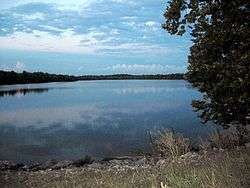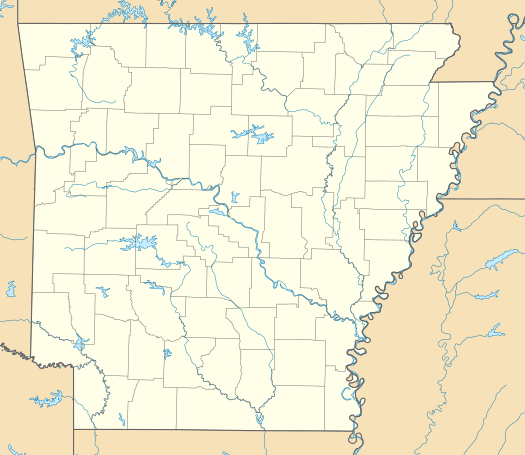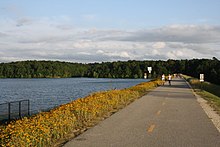Lake Fayetteville
Lake Fayetteville is a reservoir of Clear Creek created by Lake Fayetteville Dam in 1949 in Fayetteville, Arkansas.[1] Bordered on the north by Springdale, the lake was created as a water supply for the City of Fayetteville, but now serves as recreational lake surrounded by residential neighborhoods and as a focal point along the Razorback Regional Greenway for cyclists and trail users throughout Northwest Arkansas.
| Lake Fayetteville Dam | |
|---|---|
 View of the lake from the dam | |
 Location of Lake Fayetteville Dam in Arkansas | |
| Country | United States |
| Location | Fayetteville, Arkansas |
| Coordinates | 36°8′8″N 94°8′21″W |
| Status | Open |
| Construction began | 1949 |
| Owner(s) | City of Fayetteville |
| Reservoir | |
| Creates | Lake Fayetteville |
| Total capacity | 286,000,000 cubic feet (8,100,000 m3) |
| Surface area | 14.9 square miles (3,900 ha) |
| Maximum length | 1,733 feet (528 m) |
| Maximum water depth | 49 feet (15 m) |
| Normal elevation | 1,257 feet (383 m) |
History
Lake Fayetteville was used as a water supply for Fayetteville until the creation of Beaver Water District, a regional provider whose source is Beaver Lake.
The Clear Creek watershed contains rapidly developing areas of both cities; as a result, stormwater washes sediment and dissolved nutrients into Lake Fayetteville, including nitrogen and phosphorus. The lake has undergone eutrophication, and occasionally has toxic algal blooms.[2]
Amenities
Lake Fayetteville has a marina operated by the City of Fayetteville and fishing piers. The lake contains bass, crappie, carp, bluegill, and catfish.[3]

The lake has long had a nature trail around the lake, including passing through the Botanical Garden of the Ozarks. The Lake Fayetteville Nature Trail is a dirt path with tree markers passing through the oak-hickory forest typical of the Ozark Mountains. The first segment of paved trail connecting to the Razorback Regional Greenway was completed in 2007,[4] with a full 4.5 miles (7.2 km) paved trail around the lake completed in 2013.[5] The nature trail was rehabilitated and expanded into a mountain biking trail beginning in 2010.
Students from Fayetteville Public Schools and Springdale Public Schools have jointly studied the water for biology and hydrology classes using the Springdale-Fayetteville Center for the Study of Aquatic Resources on the lake since 1974.[6]
After an risk-based inspection by the Arkansas Natural Resources Commission describing a consequence of failure submerging the city of Johnson, Arkansas, the City of Fayetteville removed many large sycamore trees from the dam in 2017, and planted wildflowers.[7]
References
- U.S. Geological Survey Geographic Names Information System: Lake Fayetteville
- "Toxic algae found in Fayetteville lake - Avoid contact with water, agency says". Northwest Arkansas Democrat-Gazette. June 5, 2020. Retrieved July 4, 2020.
- Putthoff, Flip (April 11, 2017). "Carp go for bread, vanilla at Lake Fayetteville". Arkansas Democrat-Gazette. Little Rock. Retrieved July 4, 2020.
- Ward, Kate (September 6, 2007). "Expanded trail provides more activity around Lake Fayetteville". The Northwest Arkansas Times. Fayetteville. p. 1. Retrieved July 4, 2020 – via NewsBank.
- Walsh, Joel (January 12, 2012). "City To Extend Lake Fayetteville Loop - Trail Connection Welcome Addition for Hikers, Bikers". Springdale Morning News. Springdale. p. 4. Retrieved July 4, 2020 – via NewsBank.
- McNeely, Brooke; Bennett, Brett (January 27, 2005). "Keeping science afloat - Lake Fayetteville still 'most studied lake in Arkansas'". The Northwest Arkansas Times. Fayetteville. p. 1. Retrieved July 4, 2020 – via NewsBank.
- Ryburn, Stacy (June 18, 2017). "City prepares to remove trees from Lake Fayetteville dam". Northwest Arkansas Democrat Gazette. Retrieved July 4, 2020.